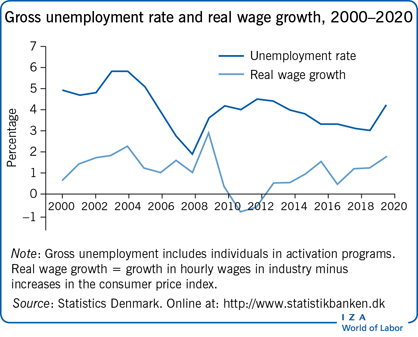Elevator pitch
Denmark is often termed a “flexicurity” country with lax employment protection legislation, generous unemployment insurance, and active labor market policies. This model is not a safeguard against business cycles, but has coped with the Great Recession and the Covid-19 pandemic, avoiding large increases in long-term and structural unemployment. The pandemic has had severe effects due to restrictions and lockdowns, but the recovery and re-openings in late 2020 and spring 2021 have been strong, indicating that the labor market effects are mainly temporary. Recent reforms have boosted labor supply and employment. Real wage growth has been positive and responded—with some lag—to the developments in unemployment.

Key findings
Pros
Employment rates are high and employment increased due to cyclical factors and structural reforms.
High job turnover rates ensure that most unemployment spells are short, which helps prevent a rise in structural unemployment.
Resilience to crises like the Great Recession and the Covid-19 pandemic avoid sharp increases in long-term and youth unemployment.
Wage adjustment has been flexible, preserving wage competitiveness.
There are few working poor due to high minimum wages and a compressed wage structure.
Cons
A large share of youths enters the labor market with low qualification levels; this is especially challenging because there are few low-skilled jobs.
Immigrants from low-income countries have low employment rates.
The high rate of job turnover may reduce human capital accumulation.
Wage inequality is widening somewhat.
Average working hours are low.